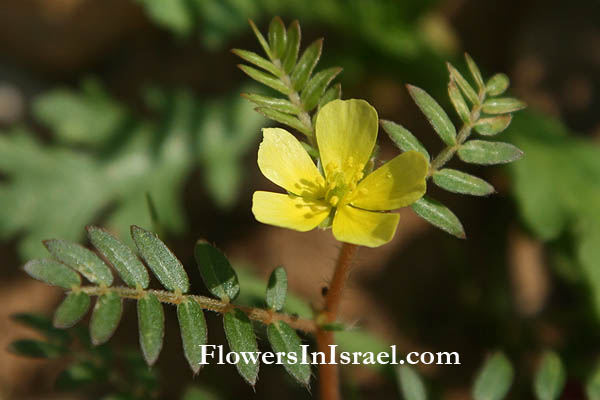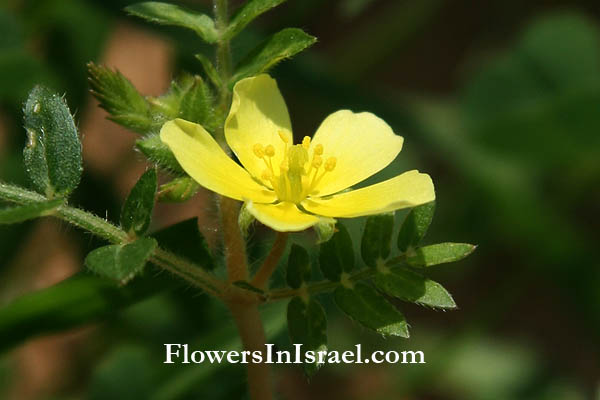Cathead, Yellow vine, Goathead,
Hebrew: קוטב מצוי, Arabic: جريس
| Scientific name: | Tribulus terrestris L. | |
| Common name: | Puncturevine, Caltrop, Cathead, Yellow vine, Goathead | |
| Hebrew name: | קוטב מצוי | |
| Arabic name: | جريس | |
| Plant Family: | Zygophyllaceae, Caltrop Family, זוגניים |

|
| Life form: | Therophyte, annual | |
| Spinescence: | Fruits | |
| Stems: | Highly branched stems generally less than 1 m long (up to 2.4 m), branching radially from the crown | |
| Leaves: | Alternate, opposite, compound, pinnate, dentate or serrate | |
| Flowers: | Yellow | |
| Fruits | Four or five single-seeded nutlets; hard and bearing two to three sharp spines, 10 mm long and 4–6 mm broad point-to-point. These nutlets resemble goats' or bulls' heads | |
| Flowering Period: | April, May, June, July, August, September | |
| Habitat: | Cultivated areas (weeds) | |
| Distribution: | Mediterranean Woodlands and Shrublands, Semi-steppe shrublands, Shrub-steppes, Deserts and extreme deserts, Montane vegetation of Mt. Hermon | |
| Chorotype: | Euro-Siberian - Med - Irano-Turanian | |
| Summer shedding: | Ephemeral |

Derivation of the botanical name: Tribulus, an instrument resting on three of its iron prongs, while a fourth projected upward, thrown on the ground to impede an enemy's cavalry, a caltrop. Transfer from its resemblance in form; a kind of thorn or thistle, land-caltrops: Tribulus terrestris, Linn. terrestris, of or belonging to the earth or land; growing on the ground. caltrop is derived from the Latin calcitrapa (foot-trap). The Hebrew name: קוטב, kotev, from Arabic: kotaba.
Dardar, דרדר, translated τρίβολος, trı́bolos in the Septuagint: Genesis 3:18; Hosea 10:8, English Versions of the Bible "thistle". τρίβολος also occurs in the New Testament: Matthew 7:16, "thistle"; Hebrews 6:8, the King James Version "briers" the Revised Version (British and American) "thistles". The Hebrew word dardar, דרדר is a species of the star thistle, perhaps the Centaurea iberica. Centaurea iberica is one of the commonest weeds of the eastern Mediterranean. see: Thorns and Thistles in the Bible |